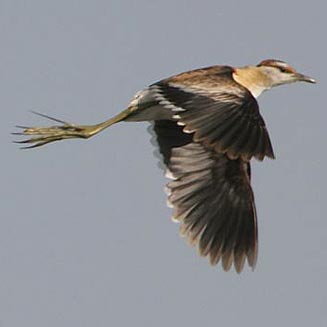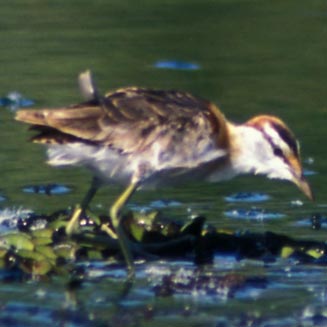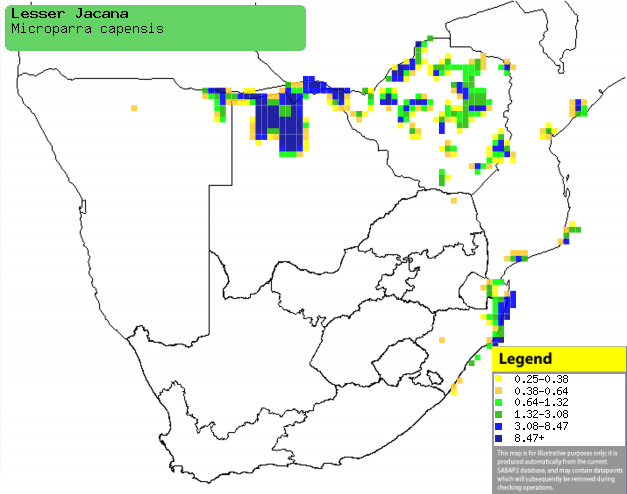|
Microparra capensis (Lesser
jacana)
Dwerglangtoon [Afrikaans]; Nkongoro gwakambatu
[Kwangali]; Dwergjacana [Dutch]; Jacana nain [French]; Zwergblatthühnchen
[German]; Jacana-pequena [Portuguese]
Life
> Eukaryotes >
Opisthokonta
> Metazoa (animals) >
Bilateria >
Deuterostomia > Chordata >
Craniata > Vertebrata (vertebrates) > Gnathostomata (jawed
vertebrates) > Teleostomi (teleost fish) > Osteichthyes (bony fish) > Class:
Sarcopterygii (lobe-finned
fish) > Stegocephalia (terrestrial
vertebrates) > Tetrapoda
(four-legged vertebrates) > Reptiliomorpha > Amniota >
Reptilia (reptiles) >
Romeriida > Diapsida > Archosauromorpha > Archosauria >
Dinosauria
(dinosaurs) > Saurischia > Theropoda (bipedal predatory dinosaurs) >
Coelurosauria > Maniraptora > Aves
(birds) > Order: Charadriiformes
> Family: Jacanidae
 |
 |
| Lesser jacana. [photo
Trevor Hardaker ©] |
Lesser jacana. [photo Peter Steyn ©] |
Distribution and habitat
Occurs discontinuously in sub-Saharan Africa, including
patches of the area from Senegal to Ethiopia, however it is especially
widespread from Uganda, Tanzania, Zambia and Angola to southern Africa. Within
southern Africa it
is uncommon to locally common in eastern KwaZulu-Natal, small parts of
Mozambique and Zimbabwe, while it is most common in northern Botswana and the
Caprivi Strip (Namibia). It generally prefers shallow, freshwater wetlands and
backwaters of lakes and dams, especially with emergent grasses (such as
Leersia and Hemarthria), sedges (including Rhynchosporia,
Eliocharis, Cyperus and Juncus) and water-lilies (mainly
Nymphaea and Nymphoides).
|
 |
|
Distribution of Lesser jacana in southern Africa,
based on statistical smoothing of the records from first SA Bird Atlas
Project (©
Animal Demography unit, University of
Cape Town; smoothing by Birgit Erni and Francesca Little). Colours range
from dark blue (most common) through to yellow (least common).
See here for the latest distribution
from the SABAP2. |
Movements and migrations
Highly nomadic, moving in search of fresh
ephemeral wetlands.
Food
It mainly eats insects, doing most of its foraging by
walking on floating plants, plucking prey from the vegetation.
Breeding
- Monogamous, solitary nester; the male builds several simple display
platforms, giving a hooting call in order to attract females.
- The nest is built by both sexes, consisting of a tiny floating stack of
plant stems, typically placed alongside a grass or sedge tuft. If it is
flooded both adults work tirelessly to build a new platform to move the eggs
to.
- Egg-laying season is from February-November, peaking from March-April.
- It lays 2-5 eggs, which are incubated by both sexes for approximately 21
days.
- The chicks remain within two metres of the nest for the first three days
of their lives, ranging up to 150 metres away by the time they reach 17 days
of age. When threatened they dive underwater, with just the bill tip
protruding so that they can breathe. The parents intermittently brood them
for the first month or so of their lives by holding them between wing and
body. They typically take their first flight at roughly 32 days old and can
fly well a week later, becoming fully independent at approximately 63 days
old.
Threats
Not-threatened globally, but Near-threatened in
South Africa, due its small population and decreasing range in the country.
References
-
Hockey PAR, Dean WRJ and Ryan PG 2005. Roberts
- Birds of southern Africa, VIIth ed. The Trustees of the John Voelcker
Bird Book Fund, Cape Town.
|
